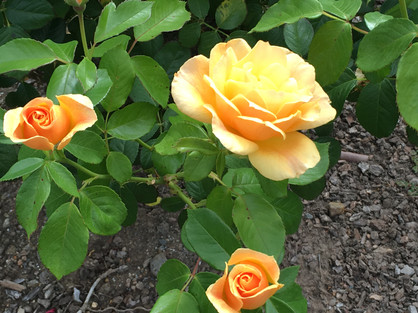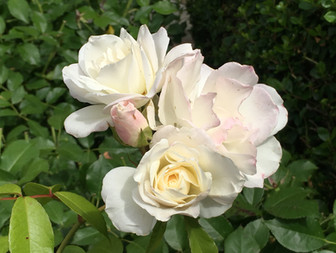Rooted in Nature: Finding Inspiration in the Flower Garden
- Melanie Grant

- Aug 19
- 4 min read
TRANQUIL • LUMINOUS • ROOTED
Stories from the studio, reflections on process, and the art of the handmade.
There’s a simple kind of magic that happens when I step outside with fresh eyes and an open sketchbook. For me this summer, inspiration is blooming just outside my door—in the unruly, radiant wonder of my own flower garden. My garden isn’t filled with rare or exotic plants—in fact, it’s quite the opposite. I grow things that are familiar, resilient, and reliable. These are plants that return each year, undeterred by the deep freeze of our northern winters, waking up again with unfettered determination. With the rhythm of petals opening to the sun, the intricate interplay of shadow and shape, and the ever-changing palette of colors, all have stirred something new in my creative process.
The natural world has long served as a faithful muse to artists including me. Whether through sweeping landscapes or close-up studies of botanical detail, nature invites my attention to pause, observe, and create. In this post, I will explore how artists have drawn from nature, and techniques for weaving the outdoors into your work, and why stepping outside with your materials can refresh both your art and your spirit.
Artists Who Draw Inspiration from Nature
Many celebrated artists have found their deepest creative wells in the natural world:
Claude Monet A pioneer of painting en plein air, Monet chased light across lily ponds and wheat fields, documenting the same view under shifting skies and seasons. His work invites us to witness how nature never stands still.
Georgia O’Keeffe O’Keeffe’s iconic flowers and desertscapes speak to the power of looking closer. With bold color and simplified form, she elevated the ordinary bloom into something near spiritual.
Ansel Adams Through the lens of his camera, Adams captured the awe-inspiring majesty of American landscapes. His images don’t just depict nature—they celebrate it.
Andy Goldsworthy Goldsworthy’s ephemeral land art—crafted from leaves, ice, stone—reminds us that beauty exists in impermanence. His pieces become part of the landscapes they inhabit, eventually returning to the earth.
Techniques for Bringing Nature and your Flower Garden Inspiration into Your Work
Perhaps you’re working in collage, watercolor, or bookbinding, there are countless ways to incorporate the richness of nature into your creative practice:
Use Natural Materials Press flowers between book pages. Stitch leaves into fiber art. Collage with bits of bark, seed pods, or sand. Let the textures of the earth become part of your medium.
Capture Light and Shadow Pay close attention to how light plays across petals, leaves, and ground. Painting or photographing at different times of day can shift the mood of your piece entirely.
Study Texture and Pattern From the soft fuzz of a lamb’s ear leaf to the bark’s deep grooves, nature offers tactile inspiration. Recreate those sensations with layered paint, textured paper, or stitch.
Borrow from the Earth’s Palette A foggy morning offers subtle greys and cool blues. A field of wildflowers bursts with joyful contrast. I love how the seasons can guide color choices.
Why Take Your Art Outside?
Stepping into nature isn’t just good for your art—it’s good for you.
Sharpen Your Observation Outdoor sketching demands presence. You begin to notice the subtle curves of a petal in the Flower Garden or the way wind shifts a branch. It trains your eye and deepens your connection to your subject.
Reduce Stress There’s something deeply grounding about creating under an open sky. The act of making becomes meditative—calming, clarifying, and restorative.
Capture Atmosphere Photographs can be useful, but they often flatten a scene. When you draw or paint on location, you capture not just what it looks like—but how it feels.

My supplies on the go
Practical Tips for Outdoor Art
What to Bring: Keep it light. A Tinker Tote, a sketchbook, a few pencils or watercolor pans, a small water jar, and maybe a foldable stool are plenty.
Where to Go: Find a spot that brings you peace—your backyard, a local park, even a quiet sidewalk garden. What matters is that you feel at ease there.
How to Begin: Start with a few loose, quick sketches. Don’t aim for perfection. Just let yourself observe and respond. The goal is to connect, not to impress.
Nature has an open invitation for all of us. It doesn’t demand a masterpiece—only your attention. So wherever you are, whether near a wild coastline or among the blooms of your backyard, let yourself be still for a moment. Let the wind, the light, and the rhythm of the seasons find their way into your hands. You might just discover that your next masterpiece is waiting… just outside the door.
Let’s Keep the Conversation Going
Where do you find your perfect patch of earth to spread out your materials and let the landscape inspire you? I would love to hear what’s blooming in your world. Leave a comment or connect with me on Instagram @melaniegrantdesign. Follow along with my art journey; Join my mailing list to see new finished pieces and get first access to new releases.






































Comments